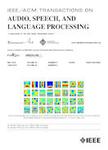版权所有:内蒙古大学图书馆 技术提供:维普资讯• 智图
内蒙古自治区呼和浩特市赛罕区大学西街235号 邮编: 010021

作者机构:MIT Cambridge MA 02139 USA
出 版 物:《IEEE TRANSACTIONS ON SPEECH AND AUDIO PROCESSING》 (IEEE Trans Speech Audio Process)
年 卷 期:1998年第6卷第4期
页 面:338-351页
核心收录:
基 金:National Institute on Deafness and Other Communication Disorders NIDCD (DC00270 N01-DC-5-2107)
主 题:adaptive filtering adaptive noise cancellation LMS algorithm noise reduction
摘 要:A desired signal corrupted by additive noise can often be recovered by an adaptive noise canceller using the least mean squares (LMS) algorithm. A major disadvantage of the LMS algorithm is its excess mean-squared error, or misadjustment, which increases linearly with the desired signal power. This leads to degrading performance when the desired signal exhibits large power fluctuations and is a serious problem in many speech processing applications. This work considers two modified LMS algorithms, the weighted sum and sum methods, designed to solve this problem by reducing the size of the steps in the weight update equation when the desired signal is strong. The weighted sum method is derived;from an optimal method (also developed in this work), which is not generally applicable because it requires quantities unavailable in a practical system. The previously proposed, but ad hoc, sum method is analyzed and compared to the weighted sum method, Analysis of the two modified LMS algorithms indicates that either one provides substantial improvements in the presence of strong desired signals and similar performance in the presence of weak desired signals, relative to the unmodified LMS algorithm. Computer simulations with both uncorrelated Gaussian noise and speech signals confirm the results of the analysis and demonstrate the effectiveness of the modified algorithms. The modified LMS algorithms are particularly suited for signals (such as speech) that exhibit large fluctuations in short-time power levels.